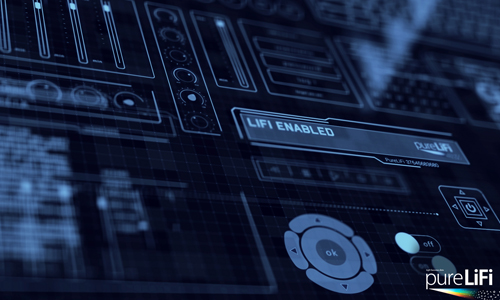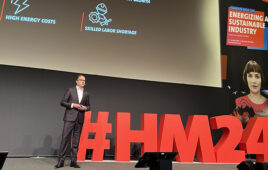Here’s an interesting approach to wireless, and potentially IoT, technology.
LiFi (light fidelity) has advanced to the point of introducing a new form of mainstream implementation. This technology uses the same LED lights that illuminate a work space to transmit secure, high speed, wireless data at rates that can go beyond those possible with Wi-Fi.
This new development results from the introduction of the first LED “light bar” fixtures equipped with the required transmission technology and designed to replace fluorescent tubes.

File access is permitted only if a device is connected to the LiFi network. Once a user connects to a LiFi network, they can download and modify certain files.
With an estimated 3-4 billion installed fluorescent tubes throughout the world, the integration of built-in LiFi transmission technology in new and retrofit LED light bars is moving LiFi beyond the pilot stage to full-scale implementation in offices, schools, warehouses and other facilities.
“LiFi is not a concept, it is really here,” says Harald Haas, co-founder and Chief Science Officer of pureLiFi, a company spearheading the development of the technology. “If people want to engage, they can purchase the products right now.”
What is LiFi?
LiFi is a high-speed, secure, fully networked wireless communication technology similar to Wi-Fi. However, LiFi uses the entire light spectrum where Wi-Fi uses radio frequencies (RF).
To do this, the LED light fixtures used in homes and offices are outfitted with a module that controls the light for optical data transmission. The high speed light pulses are invisible to the naked eye, yet can be used to transmit data at high speeds to a receiving device located in a laptop, computer tower, cell phone or other smart device.
In the future, LiFi will be embedded into the mobile devices we use every day, as well as play a key role in machine-to-machine communication and the Internet of Things (IoT).
The use of visible light provides a host of intriguing benefits that outpace what is currently possible with the radio frequency waves used by Wi-Fi and cellular networks.
When compared to the overloaded full RF spectrum, the light spectrum is 1,000 times larger and is currently unregulated with no licensing fees.
In lab conditions the technology is already capable of 10 Gbps speeds, and with the available bandwidth potential, data transmission speeds up to 100 times faster will be possible in the near future as the technology advances.
LED lighting manufacturers push LiFi forward
According to Haas, who is considered the “father of LiFi” and has been working in the field for the past 15 years, the implementation of the technology into lighting fixtures has necessitated a close partnership with LED light manufacturers.

With the implementation of LiFi in LED lightbars, the technology is now commercially available.
“The lighting manufacturers are very important to move LiFi forward,” says Haas. “They know how to design lights and fixtures and we know what needs to be done to create high speed data networks out of light and add communication capability to it.”
Until recently, most of these fixtures were small lamps or recessed can lights. Now, one of its partners, Linmore LED, is introducing the first LiFi enabled LED light bars designed to replace fluorescent tube lighting.
With the technology, data speeds have been clocked at 43 Megabits-per-second (Mbps) up and down.
“Linmore LED is the first company to bring this technology not only into new light bar fixtures, but also be able to retrofit linear fluorescent fixtures to use the LiFi technology,” says Haas.
Linmore LED originally built its reputation in the retrofit market, uses its own proprietary designs involving optics, thermal dissipation and a number of other techniques to ensure its LED products perform in the top 1% in energy efficient in the industry.
According to Paul Chamberlain, CEO of Linmore LED, the product’s design allowed for the integration of the LiFi modules in the ideal position on the light bar, without affecting critical aspects such as lighting distribution, thermal dissipation or overall performance.
Retrofit fixtures, even those that are not LiFi enabled, are in great demand as many facilities seek to drive down energy costs by as much as 70-80% by converting to LED technology. This trend is also driven by the increased operating life of LEDs and concerns about the toxic mercury used within fluorescent lamps that complicates disposal.
“Businesses want to leverage an LED upgrade and get more than just lighting, says Paul Chamberlain, CEO of Linmore LED. “Using an existing part of a building’s infrastructure – lighting – opens up endless possibilities for many other technologies to have a deployment backbone. Internet of Things (IoT), RFID, product and people movement systems, facility maintenance, and a host of other technologies are taken to the next level with LiFi available throughout a facility.”
Security benefits
Among the expected early adopters of the technology are those that seek greater security of data transmission. Initial markets expected to adopt LiFi technology include federal government and defense, banking, financial institutions and hospitals.
Distance has always been viewed as a limitation in many communication systems, with considerable effort taken to enhance the ability of a network to send data over longer distances. LiFi takes advantage of its limited transmission distance to offer better transmission security. With LiFi, a receiving device must be directly within the cone of light to receive a broadcasted signal. Visible light, including near-infrared wavelengths, cannot penetrate opaque objects such as walls, which means that the wireless signal is constrained to within a strictly defined area of illumination.
In a man-in-the-middle attack the attacker must be able to intercept all relevant messages passing between the two victims and inject new ones. This is straightforward in many circumstances; for example, an attacker within reception range of an unencrypted wireless access point (Wi-Fi) can insert itself as a man-in-the-middle.
Because visible light is easily containable within a space, it could eliminate classic man-in-the-middle attacks where eavesdroppers located outside an area are able to intercept communications from radio waves emanating outside building.
Traditional encryption and authentication protocols used for Wi-Fi provide an additional layer of security for the LiFi network.
The ability to direct or shape light into defined areas of illumination allows precise partitioning of any environment.
File access is permitted only if a device is connected to the LiFi network. Once a user connects to the LiFi network, they can download and modify certain files. It is also impossible for a nearby employee to intercept information sent to the server/network by another employee, since the uplink communication is on a different frequency from the downlink.
Further increasing security, every device that can connect to the network can be localized and tracked using the technology. The same LiFi module enables “communication on the move” by tracking the transmission source electronically, with no moving parts.
“You can walk through a building, into different [light] zones and it will keep you connected the entire time as you move along in the building,” says Haas.
The future
The technology is expected to continue to advance under an “aggressive strategy of miniaturization and lower costs,” says Haas.
Although current technology requires use of a dongle, much like early Wi-Fi, Haas says the major mobile device manufacturers are already expecting to adopt the technology within the next 3-5 years.
pureLiFi
purelifi.com
Filed Under: IoT • IIoT • Internet of things • Industry 4.0, Wireless • 5G and more





Tell Us What You Think!